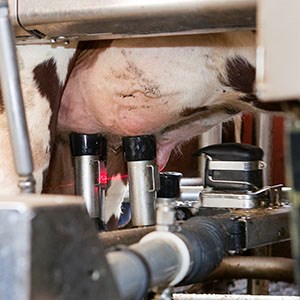Contact
Department of Molecular Sciences, Animaliska livsmedel
Department of Applied Animal Science and Welfare, Management, Ruminants

Are there differences in the proteolytic activity in milk from individual cows with different number of lactations?
Swedish dairy cows have an average life expectancy of 5 years, which means that each cow undergoes about 2.5 lactation cycles throughout her life. The productive lifespan is much shorter than the natural life expectancy of a dairy cow, which is approximately 20 years. A large proportion of dairy cows are culled before their full potential is reached. The most common reason for dairy cows being culled are e.g. impaired fertility, mastitis, unfavorable milk composition or low milk yield. Increased cow longevity, i.e. life length of the cow, is associated with better animal welfare and would also reduce the green-house gas emission intensity per unit of milk solids per cow. However, if cows should be retained in production for more lactations in the future, i.e. increase longevity and the productive life of cows, it is important that there are no negative effects on the composition and technological properties of the milk.
This masters project is part of an on-going research project funded by the Swedish farmers’ foundation for agricultural research. The objective is to investigate if there are differences in the proteolytic activity (plasmin- and plasminogen derived activity, total proteolysis) in milk from individual cows with different number of lactations. For this purpose, milk samples from 28 SRB and 80 SLB cows have been collected from dairy farms in Uppland, Västmanland and Sörmland. Mil from cows in lactations one and two (defined as young cows) will be compared with milk from cows with higher lactation numbers (defined as old cows).
Plasmin/plasminogen activity. Plasmin is the major native protease in the milk. Plasmin is responsible for casein degradation, and may cause significant loss of protein into the milk serum with lower cheese yield as a consequence. However, plasmin has also positive features during the maturation of certain hard cheeses. Here, plasmin breaks down caseins into smaller peptides, which contribute to specific sensory attributes of the final product. Plasmin activity will be measured by using a chromogenic substrate. The substrate contains one specific peptide sequence, which is cleaved by plasmin. As a result, a fluorogenic peptide is released which can be quantified, reflecting the activity of PL.
Total proteolysis determines the protein degradation in milk caused by all proteases present in milk, i.e. in addition to plasmin also microbial and cellular proteases. Proteolysis results in an increased number of peptides and free amino acids in the milk. Thus, total proteolysis can be determined by measuring the amount of terminal amino groups, e.g., by fluorescamine method. In this method, peptides and free amino acids are separated from proteins by precipitation with trichloroacetic acid. Fluorescamine is added to develop a fluorescent product from its reaction with the primary amino groups. The amount of free amino terminals thus reflects levels of total proteolysis.
Interested? Contact Monika Johansson, monika.johansson@slu.se